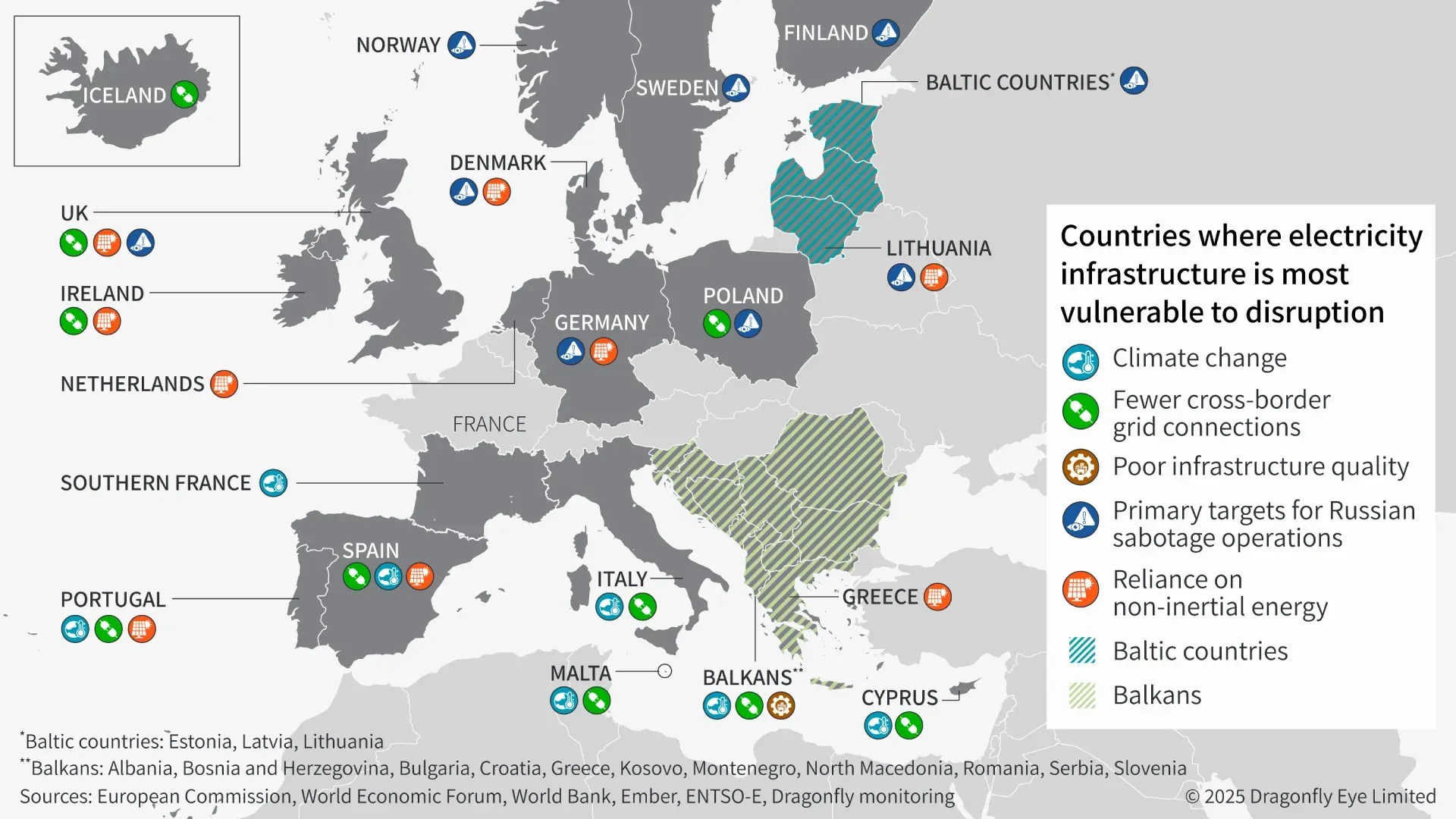
- Large-scale and prolonged energy outages are likely to remain rare in Europe in the coming years
- Power outages across Iberia caused countrywide blackouts in late April, and most recently, another affected large parts of Czechia on 4 July
- Southern Europe and the Balkans will probably remain most vulnerable to blackouts, especially during warmer months, due to poor infrastructure and climate change
Clients have asked us how vulnerable European electricity infrastructure is to disruption from critical failures. This follows outages in Spain and Portugal in late April and in Czechia in early July. We do not anticipate similar large-scale incidents to be common in the coming years. Infrastructure in most countries is robust, according to available data, and most outages are usually resolved within a few hours. But southern and Balkan countries appear to be most vulnerable to outages, especially in the summer.
Electricity infrastructure will also probably remain an attractive target for state-backed sabotage, particularly by Russia. This is regardless of the course of the war in Ukraine. However, such operations are unlikely to cause prolonged and widespread disruption; most involve espionage and do not target power supply. And most European countries have sufficient mitigation and backup capabilities.
Widespread, prolonged outages unlikely to occur often
Large-scale outages, such as in Spain and Portugal on 28 April, will probably remain an outlier in the coming years. An initial Spanish government assessment on 17 June attributed these to ‘multiple causes’, involving both technical failures and human error. These included grid overvoltage, insufficient voltage control due to programming errors, and several energy firms shutting down their substations to protect them. Given this accumulation of factors, similar disruption will probably remain uncommon. Such large-scale events have been very rare in the past several years.
Most countries appear capable of mitigating risks
Electricity infrastructure in most European countries is well-maintained and efficient. Mitigation and backup capacity during major failures seem to be generally robust across most European countries. Such incidents tend to be resolved within a few hours at most, and critical sectors like emergency services, hospitals, military and nuclear facilities tend to have backup power systems to ensure uninterrupted supply. A power outage in large parts of Czechia, including Prague, on 4 July due to a fallen high-voltage cable was resolved within around four hours.
Increasing cross-border grid connections across Europe are likely to improve backup capacity in the coming years. As of this year, 14 countries have met a 15% interconnection target set by the EU. But countries with isolated grids are likely to struggle to import electricity during critical failures. Low interconnection levels limited Spain and Portugal’s ability to do so during the outages in April. Other countries with limited connections include most Balkan nations, Cyprus, Iceland, Ireland, Italy, Malta, Poland and the UK.
Balkans more vulnerable to blackouts
Balkan countries, especially in the western Balkans, seem unable to prevent widespread disruption during surges in energy demand. Based on power outages in recent years as well as available data, Albania, Bosnia and Herzegovina, and Kosovo are the most susceptible. Outages there have lasted up to several hours and, in some remote areas, up to a few days. This seems to be due to underdeveloped or inconsistently maintained infrastructure, based on data from the World Economic Forum and the World Bank.
Outage risks likely to increase without long-term investment
Climate change, ageing infrastructure, and growing power demand are likely to increase the risk of localised, short-term outages. This is particularly in southern Europe, including Cyprus, the Balkans, southern France, Italy, Malta, Portugal and Spain, where heatwaves and droughts are worsening. High electricity demand and overheating infrastructure have caused recurrent blackouts of up to a few hours in most of these during the summer months in recent years.
The growth of wind and solar power also appears to raise vulnerability risks to national grids, without sufficient investment in integration. Following the outages in Spain and Portugal, several infrastructure experts pointed out a lack of inertia (grid stability) in these sources, meaning their networks are more vulnerable to sudden demand stress or equipment failure. Comparatively, in coal, gas, nuclear and hydro power, inertia is provided by energy being stored in heavy, continuously-spinning components.
The Spanish authorities did not blame the outages on wind and solar energy. But they have recently announced plans to improve renewable energy integration. Denmark, Germany, Greece, Ireland, Lithuania, the Netherlands, Portugal, Spain and the UK are the countries most reliant on similar sources. Since 2019, the UK has invested in expanding battery storage, after a lightning strike and a sudden grid frequency change caused a large-scale blackout.
Sabotage and cyberattacks unlikely to cause widespread disruption
Russian-backed sabotage operations, including against power infrastructure, will almost certainly continue this year. The main driver behind these is sanctions, which Europe is very unlikely to lift anytime soon. Last December, the Finnish authorities said a Russia-linked vessel had severed power cables linking Finland and Estonia. The Baltics, Denmark, Finland, Germany, Norway, Poland, Sweden and the UK are likely to remain key targets. But we doubt that Russia is trying to maximise disruption; most operations involve espionage and appear to be probing for infrastructure weaknesses.
Russia, China and ransomware groups are also likely to target the energy sector with cyber operations. Ransomware groups will probably be the main perpetrators against the sector, and tend to only disrupt IT systems and not the operational technology that would impact supply. And most countries would probably have sufficient backup capacity and cross-border cooperation options to mitigate any disruption to power supplies.
A photo taken on July 21, 2025 shows wind turbines behind electric pylons in Herten, western Germany. (Photo by Ina FASSBENDER / AFP) (Photo by INA FASSBENDER/AFP via Getty Images)




